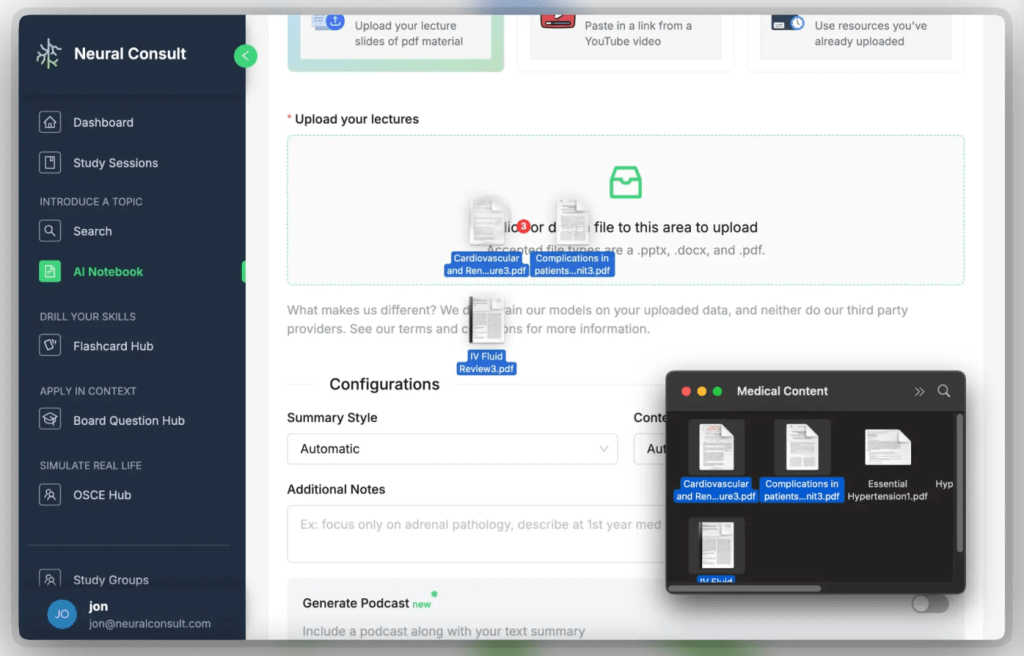Competency-based medical education (CBME) is rapidly reshaping how future physicians are trained. Instead of measuring success by seat time or course completion, CBME emphasizes demonstrated ability in real-world clinical tasks. This shift requires medical schools to rethink how learning is delivered, tracked, and refined to match each student’s pace and progression. Central to this transformation is the need for smart, personalized tools that adapt to the learner and ensure no competency is overlooked.

AI tools, especially those built with medical education in mind, offer a new kind of flexibility. The AI Lecture Notebook from Neural Consult provides a structured, intelligent workspace where students can digest complex material and generate outputs like summaries, flashcards, and board-style questions. This tool doesn’t just replace note-taking; it enhances it by organizing critical content into high-yield formats that directly support competency tracking.
In traditional models, students must self-identify gaps, often relying on test scores as their only feedback mechanism. With AI-enhanced platforms like Neural Consult, weaknesses are detected early through performance patterns in activities like flashcard review or OSCE simulations. This real-time feedback loop is key to CBME, which requires continuous, formative evaluation rather than delayed summative grading. Platforms that offer such adaptive features mirror the principles outlined in AAMC’s Core Entrustable Professional Activities, supporting learners on a path to independent practice.
Because CBME requires students to be lifelong learners, having a searchable, AI-enhanced archive of learning experiences can guide reflection and remediation. The AI Lecture Notebook creates that longitudinal database, combining study sessions, questions, and simulations into a single learning trajectory. This approach parallels learning portfolios seen in successful CBME pilot programs at institutions like McMaster University, which emphasize continuous improvement supported by technology.
Organize Knowledge Into Actionable Competencies

One of the strengths of the AI Lecture Notebook is its ability to transform passive lecture material into usable educational content. Medical students can upload PDFs, text, or structured outlines and quickly receive AI-generated summaries tied to core medical competencies. These summaries are editable and shareable, making it easier for learners to collaborate while still tailoring information to their personal needs. A review by Medical Teacher Journal found that structured summaries significantly increased student engagement in CBME-aligned programs.
Integrate Feedback Into Everyday Study Routines
What separates CBME from older frameworks is the demand for constant feedback. The AI Lecture Notebook links directly to Flashcard Hub, which helps convert lecture material into recall-based tools that reflect competency goals. This feedback can be further tested with simulations in the OSCE Simulator, creating a seamless ecosystem. It reflects how clinical education experts recommend using authentic assessments in everyday training environments.
Support Both Remediation and Acceleration
Because AI-generated summaries are dynamic, they allow students to revisit previously difficult content, tag material by competency, and focus on remediation. At the same time, students who excel can accelerate their learning by generating more challenging questions or exploring related topics via AI Medical Search. This supports the dual need for flexibility and personalization that competency-based education leaders say is essential in 21st-century medical training.
Enable Faculty Oversight Without Micromanagement
Educators can track how students are progressing through different learning assets without needing to manage every note or question manually. AI dashboards built into tools like Neural Consult allow for high-level tracking of competency exposure and student interaction. This light-touch oversight is ideal for busy faculty managing large cohorts, a model increasingly promoted by digital-first medical programs like Harvard Medical School’s HMX. The result is an efficient system that scales individualized instruction without increasing workload.
Conclusion
The AI Lecture Notebook is more than a convenience tool. It is a strategic asset for aligning student learning with the goals of competency-based education. By capturing every moment of study and translating it into competency-relevant outputs, the notebook becomes a living portfolio of clinical readiness. Medical education needs tools that match the sophistication of modern training models, and Neural Consult delivers on that need.
Unlike one-size-fits-all systems, this AI-enhanced notebook evolves with the learner. It builds feedback into each study step, encourages reflection, and supports both self-guided improvement and structured academic pathways. As more institutions adopt CBME, platforms that empower students to take control of their learning journey will become essential. Neural Consult helps medical students and faculty transition to a personalized, AI-supported model of education that reflects the best of competency-based training.